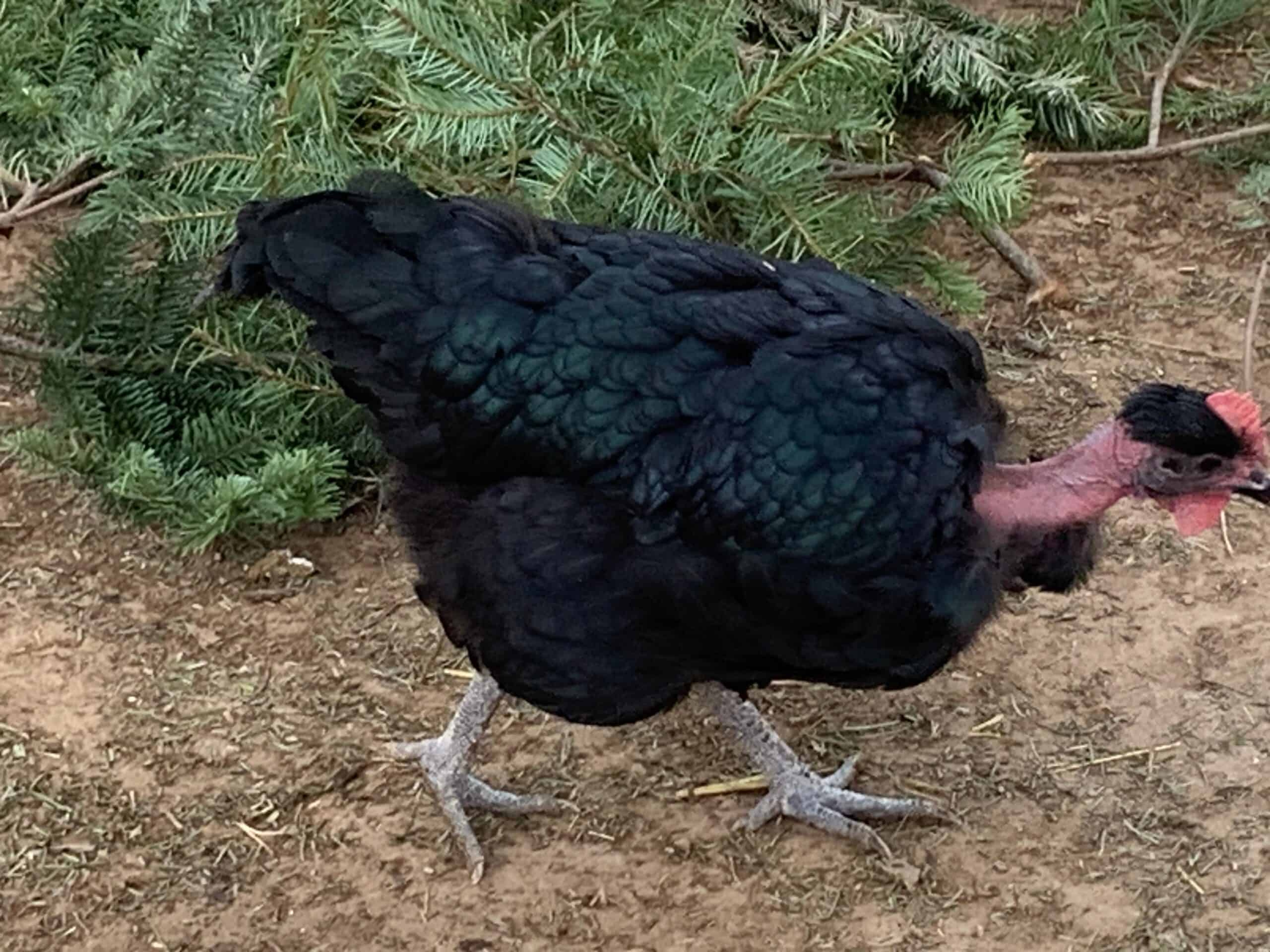Naked Neck chickens, also known as Turken or Transylvanian Naked Neck, have gained popularity as a dual-purpose chicken breed. Renowned for their distinctive resemblance to turkeys and their remarkable features, such as a featherless neck, they are valued for their hardiness, efficient feed conversion, and agreeable temperament.
As a true dual-purpose breed, Naked Neck chickens excel in both egg production and meat quality, making them a versatile choice for backyard flock owners. They display remarkable adaptability in hot climates, making them suitable for a variety of geographic regions.
Here I discuss Naked Neck chickens, exploring their temperament, personality traits, reasons to raise them, and their remarkable egg and meat production capabilities. By the end, you’ll gain valuable insights into these unique birds and why they are increasingly favored among chicken enthusiasts.
Naked Neck Chickens aka Turkens
You’ll know a Naked Neck chicken when you see one because it literally has a naked, featherless neck. It may look like it’s in the process of molting, low in the pecking order, or possibly sick, but it isn’t. This breed simply doesn’t have feathers on their necks.
Naked Neck chickens are unique because they possess a certain gene, known as BMP12. The BMP12 gene acts as a regulator for feather growth, limiting it in the head and neck regions. As a result, these chickens have a distinctive appearance — no feathers on their necks — that some mistakenly interpret as signs of an illness or abnormality.
In reality, Naked Necks are perfectly healthy birds. They may even possess advantages over other breeds. A featherless neck can:
- Help them cool down more quickly in the warm months
- Keep them from becoming burdened with wet and matted locks when subjected to rain or cold weather
Other Names for Naked Neck Chickens
Naked Neck chickens, also known as Turken chickens, have a few other names associated with them. One common alternative name is “Transylvanian Naked Neck” due to the breed’s origins in Transylvania, a region in present-day Romania.
Another name sometimes used is “Turkens,” a playful combination of “Turkey” and “chicken” that refers to the breed’s unique appearance. These alternative names reflect the breed’s distinct characteristics and add to its charm and intrigue among chicken enthusiasts.
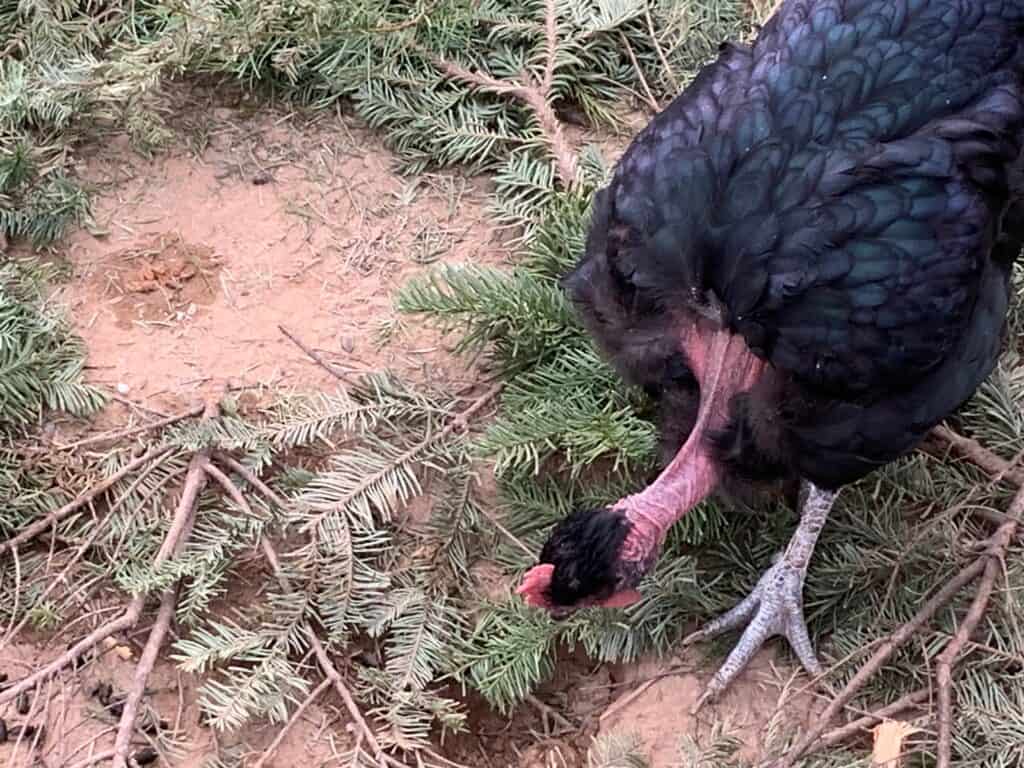
Appearance
Naked Necks will definitely stand out in your flock. They have an upright single comb, muscular build, and broad chest. Most notably, they are characterized by their lack of feathers on their necks. No, they weren’t plucked! This is their genetic makeup. It makes them look like turkeys and different from other chicken breeds.
In addition to having featherless necks, their feet and legs are featherless as well. They also have a slightly larger head with yellow beaks and shanks.
Their feathering can come in a variety of colors including buff, silver, white, black, blue, cuckoo, reddish, etc. As far as recognized varieties, the American Poultry Association recognizes red, white, buff, and black.
Naked Necks are considered a medium sized chicken breed.
- Naked neck hens typically weigh between 5 – 6.5 pounds
- Naked neck roosters are slightly larger, weighing between 7 – 8 pounds
Naked Necks Breed True
Naked Neck chickens are a heritage breed known for their distinct characteristic of breeding true. When Turkens are bred, their offspring will consistently exhibit the bare neck trait, making them easily recognizable from a young age.
This unique breeding consistency ensures that the baby chicks will inherit the naked neck trait, maintaining the breed’s distinctive appearance throughout generations.
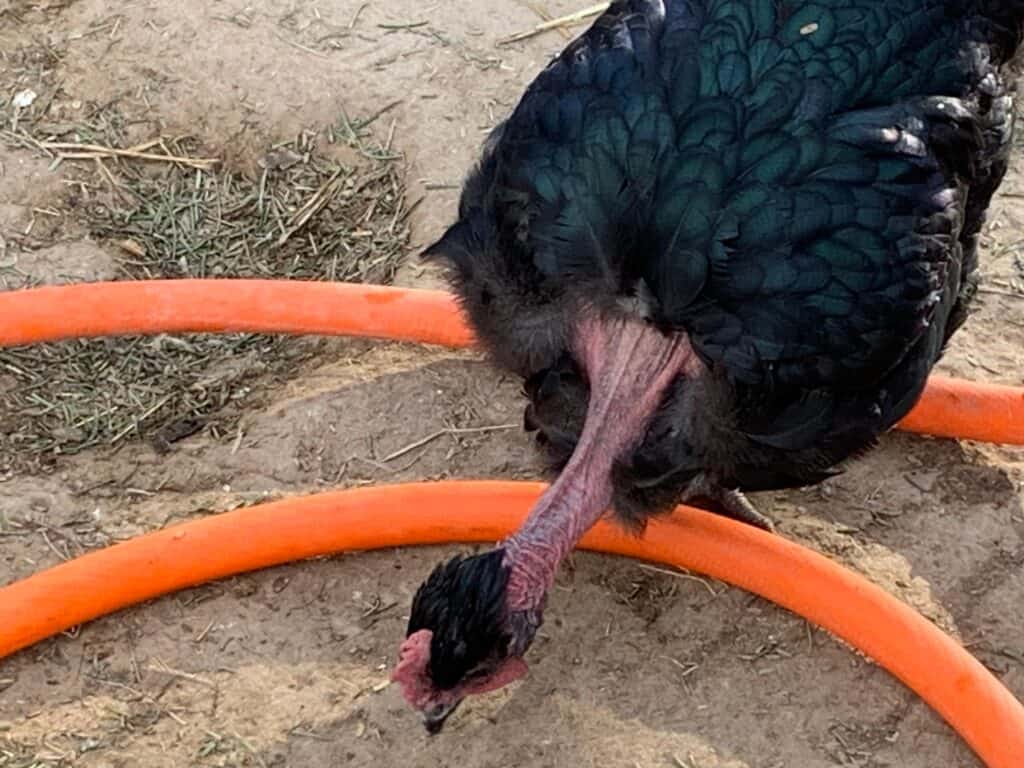
Purpose for Raising Naked Neck Chickens
- Meat production: Naked Neck chickens are known for their meat quality, which is flavorful and tender.
- Egg production: While not as prolific as some other breeds, a Naked Neck chicken produces around 130 – 150 eggs per year.
- Hardiness: Naked Neck chickens are able to tolerate both hot and cold temperatures, making them a good choice for backyard flocks.
- Easy to care for: Friendly and easy to handle, they are generally healthy, making them easy to care for.
- Dual purpose: Many people like raising them because they can use them for either eggs or meat.
There are many reasons chicken keepers raise Naked Neck chickens. They are hardy in cold and hot climates with proper shelter; they produce eggs and meat; and they are easy-going with a friendly personality. They are a good choice for beginners new to raising chickens.
Depending on your purpose for raising chickens and your comfort level with raising chickens for meat, know that with Naked Necks, aka Turkens, you get the best of both.
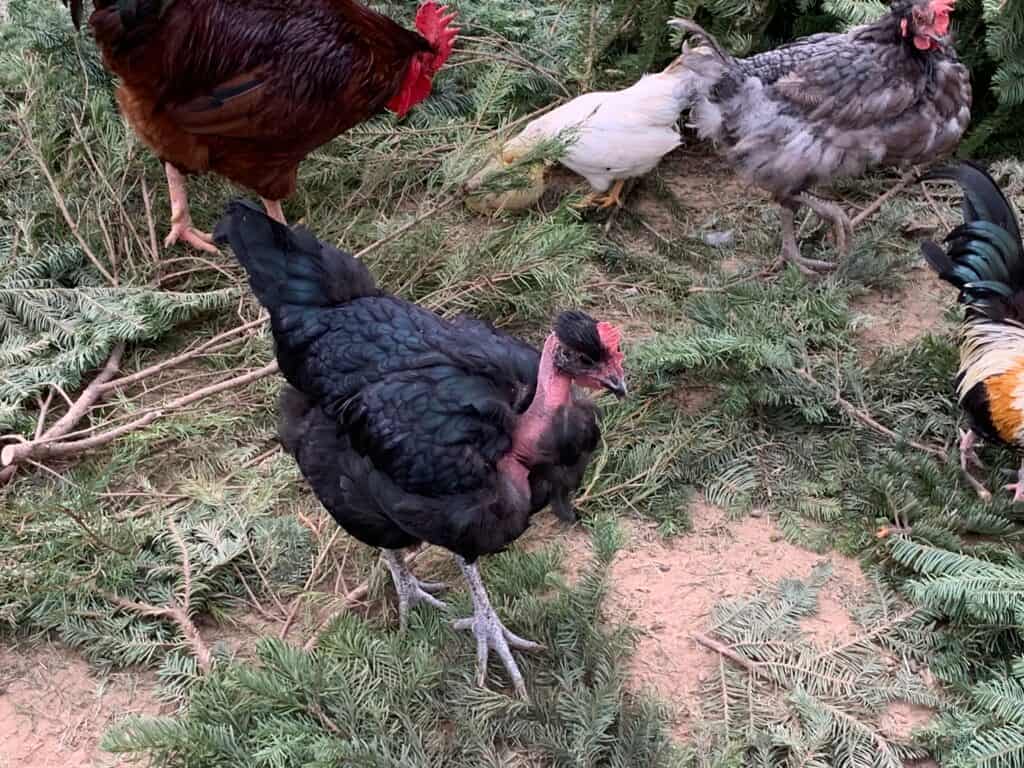
Meat
Even if you raise Naked Necks primarily for eggs, you can cull unproductive hens and the males and process them for meat. Compared to traditionally feathered birds, Naked Neck chickens have a higher dressing percentage and yield more breast muscle, giblets, and meat.
The average dressed weight of a Naked Neck chicken is around 4 – 5 pounds, depending on females and males.
Their meat is known for being flavorful and tender, making them a popular choice for meat production. Learn about some of the other best meat chickens.
Egg Production
Naked Neck hens will begin laying when they are around 6 months old. Their eggs are medium-to-large and light brown or tan. They will lay 3 – 4 eggs per week. In a year, they will lay around 130 – 150 eggs. Their egg-laying will taper off in the colder months as their exposure to daylight decreases and it gets colder.
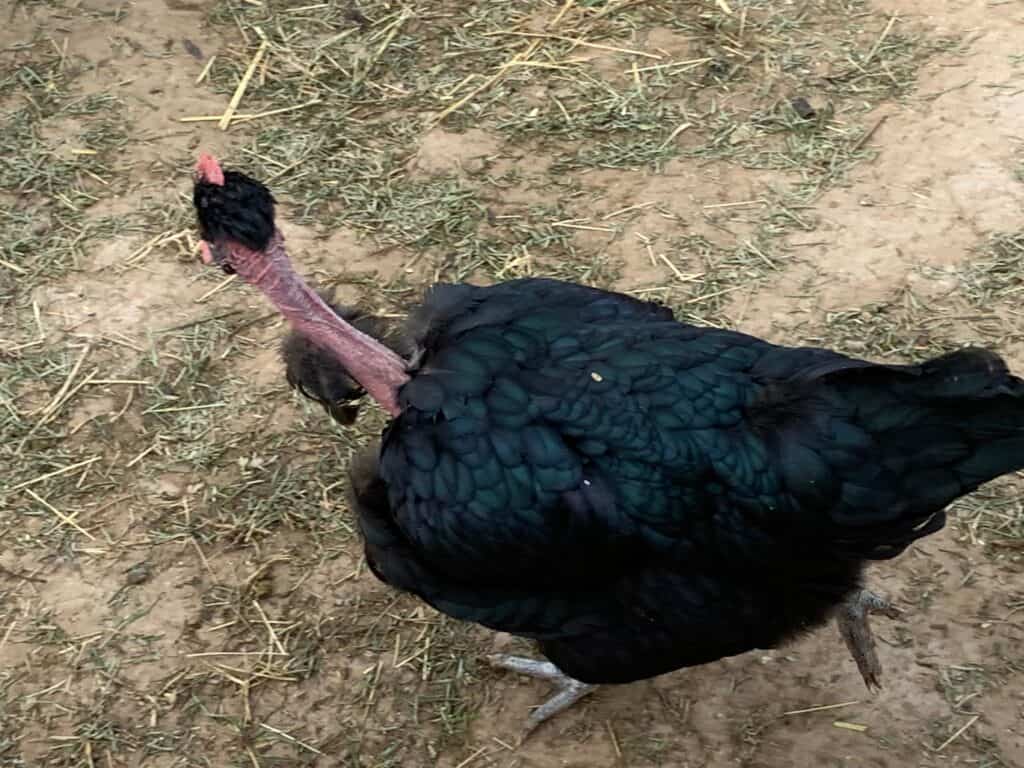
Cold and Heat Tolerant
Naked Neck hens and roosters are known for their hardiness. They are tolerant in hot and/or hot and humid climates. With proper care, including fresh water, well-ventilated spaces, shade, and proper nutrition, they are able to handle heat stress better than many other breeds. They can also thrive in cold climates.
The Transylvanian Naked Neck chicken stands out from its feathered counterparts with its signature bare neck and head. This interesting feature not only makes these birds appear unique, but also has a very functional purpose.
Exposing their skin to the sun’s rays helps them regulate their body temperature in both hot and cold climates. In cooler climates they tend to be paler in tone with a lighter pink color whereas in hotter or more tropical climates they are a deep red or dark red color.
If raising them in hot climates, be sure to provide access to shade, especially during the hottest parts of the day. They may require extra care during extreme weather conditions, such as very cold winters or very hot summers, but overall they are able to adapt to many different climates.
At low temperatures, Naked Necks produce fewer eggs and have an overall lower egg mass.
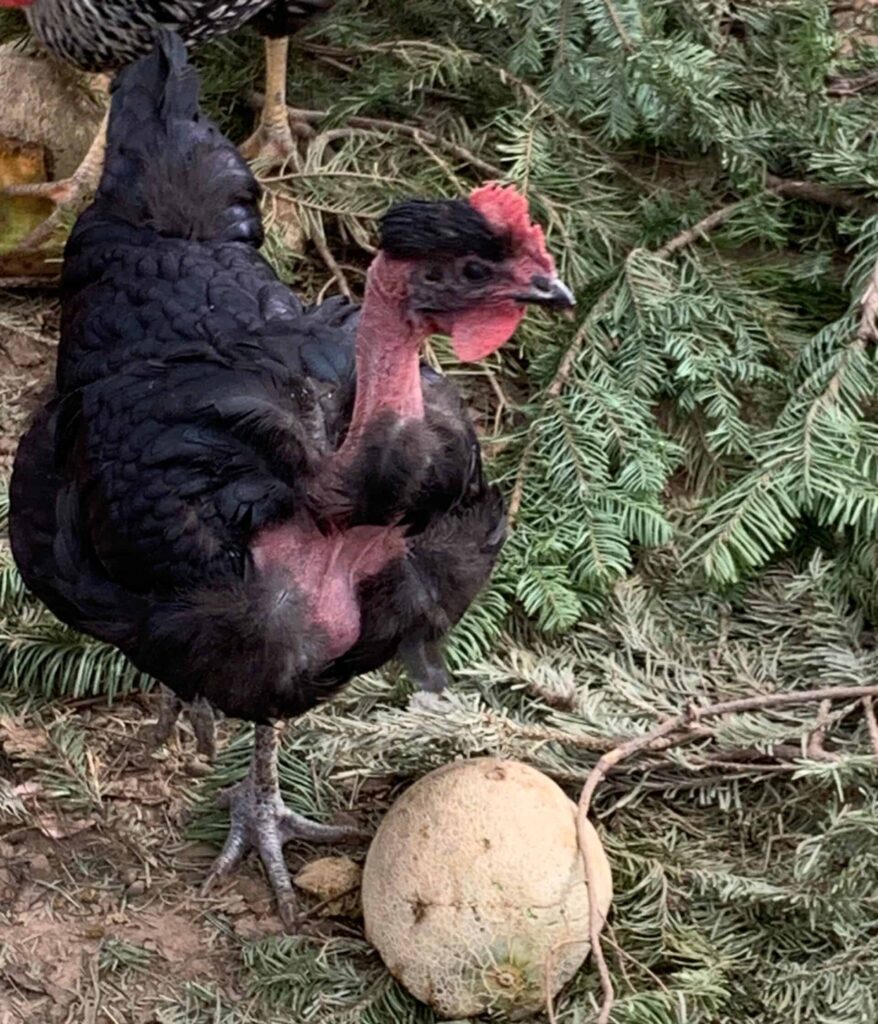
Naked Neck Temperament & Behavior
Transylvanian Naked Neck chickens are known for easy-going temperament. They are generally friendly and social with humans though I wouldn’t consider them to be lap chickens.
For the most part, they get along in a mixed flock with other mild-mannered, non-aggressive chickens. They are social birds and enjoy being part of a flock, whether it’s all Naked Necks or a mix of different breeds. They are known for being friendly and not threatening, and are not aggressive toward other birds.
Some of the breeds that should get along well with Naked Necks include Rhode Island Reds, Plymouth Rocks, and Leghorns, Orpingtons, and California Whites, among others.
However, it’s always a good idea to introduce new birds to the flock gradually, to minimize the risk of aggression or bullying. They will be lower in the pecking order so keep them away from aggressive breeds.
Like most all chickens, this breed will benefit from having enough space, fresh air, and the ability to be out free-ranging or the opportunity to be in a chicken run. They are also good foragers and can help with managing insects.
At times they can be loud and chatty. Keep this in mind if you have neighbors close by.
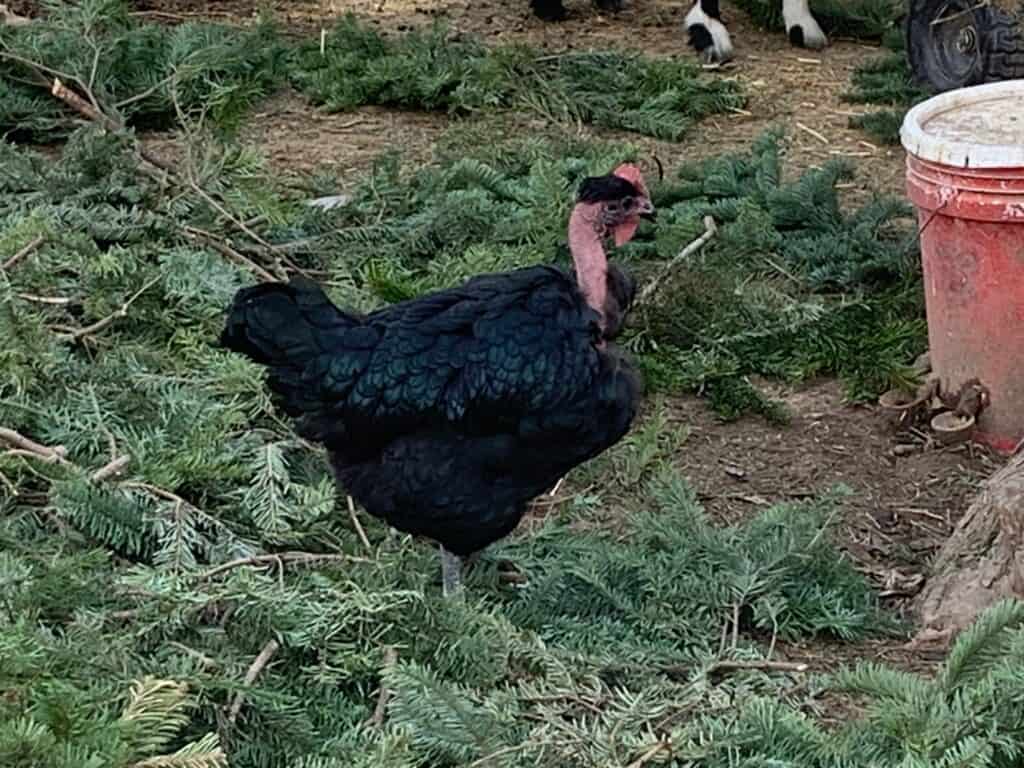
Hens Can Be Broody
According to Michigan State University College of Agriculture & Natural Resources, Naked Neck hens are likely to go broody (sit on their eggs to hatch them).
This means, if you keep a rooster, your Turken hens may sit and hatch chicks. Being this breed is a good egg layer, many owners don’t want them to sit on their eggs and would rather maximize egg production. So instead of letting the hens sit, you can collect the eggs, and keep them in an incubator until they hatch.
Note that while Naked Neck chickens are known to be broody, there can be individual variations in behavior. Some may not go broody nor exhibit mothering behavior. Factors such as age, genetics, and environmental conditions can also play a role in broodiness and mothering behavior.
Overall, they are known to be good mothers. They are attentive to their chicks and will protect them from danger. They are also good at teaching their chicks how to forage and find food, which can be helpful for those who want to raise their chickens in a more natural, free-range environment.
Naked Neck Rooster
Naked Neck roosters, like their female counterparts, are known for their hardiness and easy-going temperament. They are generally friendly and social with humans, and are known to be good protectors of their flock. They are naturally alert and will sound the alarm if they perceive a threat, such as a predator or intruder.
While some roosters can be aggressive toward humans and other birds, especially when they perceive there to be a threat, Naked Neck roosters are not aggressive. They are mild-mannered, friendly, and easy to handle.
The roosters will do well in mixed flocks, interacting well with other breeds of chickens, especially if there is only one rooster.
Be sure to have a minimum of 8 – 10 hens if you keep a rooster in your flock. This will minimize stress on the hens.
Naked Neck chickens are known for their meat quality, with both hens and roosters being used for meat production. The meat is flavorful and tender, making them a popular choice for backyard meat production. This means if you keep a rooster and hatch chicks, you can cull the males for meat in 8 – 12 weeks.
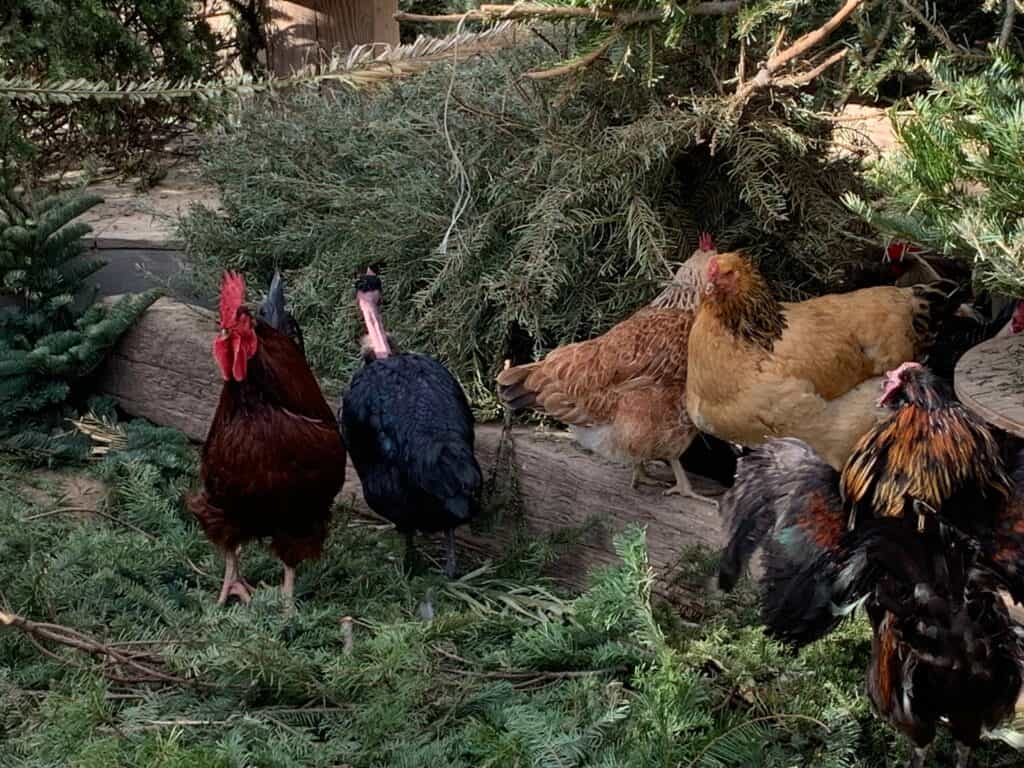
Potential Drawbacks of Raising Naked Neck Chickens
While there are many benefits to raising Transylvanian Naked Necks, there are also some potential drawbacks to consider. These include:
- Appearance: Some people may not find the naked neck look appealing.
- Vulnerability to health issues: Naked neck chickens may be more susceptible to certain health issues, such as sunburn, due to their lack of feathers on their necks.
- May be lower in the pecking order and can get bullied from more aggressive breeds.
- Can be loud at times.
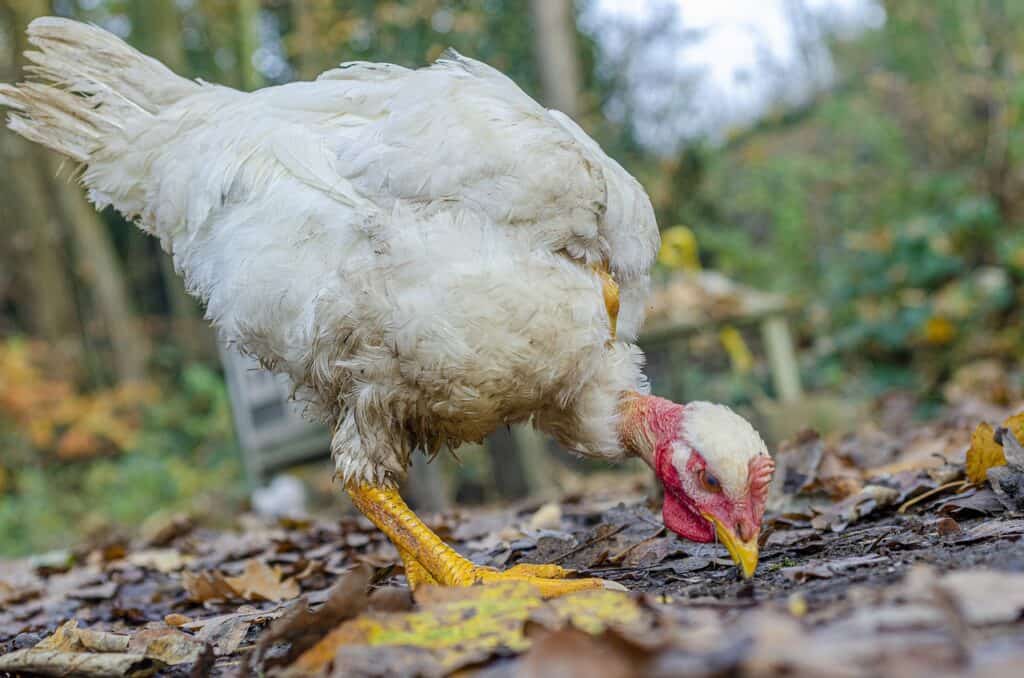
Naked Neck Chickens History and Origin
Naked neck chickens are believed to have originated in Transylvania, in the area now known as Romania. They were first bred for their meat and their ability to survive in harsh environments. They were later brought to other parts of the world, including the United States, where they were also used for meat production.
FAQs
What kind of climate do Naked Neck chickens do best in?
Naked Neck chickens are known for their hardiness and adaptability, making them able to thrive in a wide range of climates. With proper care and shelter, they can tolerate hot and cold temperatures.
Do Naked Neck chickens get along with other breeds?
Yes, a Naked Neck chicken will get along with other mild-mannered and friendly chicken breeds. They do well with Orpingtons, Rhode Island Reds, California White chickens, Silkies, Polish chickens, and more.
Do Naked Neck chickens go broody?
Naked Neck chickens are known for their low level of broodiness, meaning they are less likely to go “broody” (sit on their eggs to hatch them) than some other breeds. This can be an advantage for those who want to maximize egg production, as broody hens will stop laying eggs until their chicks hatch.
What color eggs do Naked Neck chickens lay?
Naked Neck chicken will lay light brown eggs.
When do Naked Neck chickens start laying eggs?
Hens will start laying when they are approximately 6 months old.
Where to buy Naked Neck chickens?
I know for sure if you live in a hot climate, you will be able to find Naked Neck chicks in feed stores. They are also at my local ACE Hardware store. You can also buy fertile eggs from hatcheries online or locally if you have them in your area. You may also be able to look locally to see if anyone sells them.
What are Turken eggs?
Turken eggs are the same as eggs from Naked Neck chickens. They are light brown and medium in size.
What are other names for Naked Neck chickens?
Other names for this breed without feathers on its neck is Turken or Transylvanian Naked Neck. Many people think they resemble turkeys.
Raising Naked Neck Chickens
Naked Neck chickens are a unique and hardy breed that are well-suited to backyard flocks. They are easy to care for and provide both meat and eggs for their owners. While their appearance may not be for everyone, they are a great choice for those looking for a low-maintenance and adaptable breed of chicken.
They are able to tolerate both hot and cold temperatures, making them a good choice for backyard flocks. They are also known for their tender meat quality. You can raise productive hens for their eggs.
While other chickens breeds may experience heat stress in very hot climates (consider the southwestern United States in the summertime), Turkens do well in hot temperatures. They require fresh water, plenty of nutritious feed, and proper shelter to keep them out of the sun.
They are friendly which makes them ideal for beginners getting started in chicken raising. Another reason to raise Transylvanian Naked Neck chickens is they offer great feed efficiency. This means they consume smaller quantities of feed while also providing larger yields of eggs or meat than other breeds.
You may consider their lack of broodiness a pro or a con. It’s a positive trait because the hens will continue to lay eggs rather than stop their egg production to sit on their eggs.
At the same time, some flock owners may consider it a negative because they also raise a rooster and want to hatch chicks without using an incubator.
Learn more about raising chickens. I have lots of information about raising the best egg laying chickens along with meat breeds, and more.
Want to raise Naked Neck chickens alongside other dual-purpose, friendly chickens? Read about the California White chicken, the Jersey Giant chicken, Orpingtons, and the Dominque chicken. They would all do well with friendly Turkens.
If you live in colder region and want to raise a friendly mixed flock, consider raising Icelandic chickens with Naked Necks.
Learn about how much space do chickens need and the best chicken bedding for our situation. If you are considering adding a rooster to your backyard flock, consider the pros and cons to raising a rooster.
Featured image credit for black Naked Neck chicken: Dawn Head

